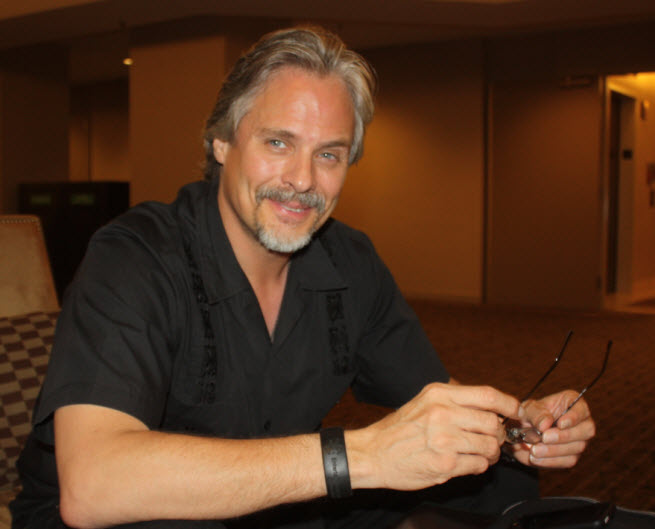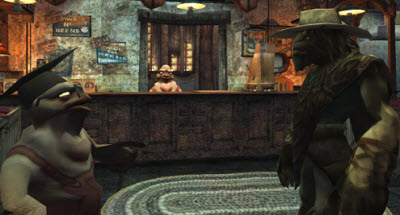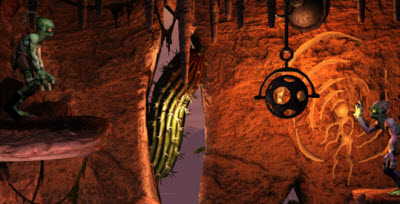GamesBeat: Then what did you do?
Lanning: This is where that dialogue with our audience led us to where I was telling you earlier. They said, “Redo Abe’s Oddysee like you redid Stranger.” We looked at it and said, “We want to get on the Unity platform anyway. We want to learn more about it. We think it’s going to be a powerful player in the future. It’s the indie platform. What if we do Abe’s Oddysee in 3D technology, with real lighting to make those environments come alive? What if we fix all the things that weren’t right about it and make it a better game?”
Watch all these movies that are being remade, like The Manchurian Candidate or The Time Machine. The list goes on. They’re never as good as the originals. We said, “What if we don’t try to rewrite it? What if we just redo that script, that game?” But instead of fixed-screen platforming, we have continuous side-scrolling. We don’t have pre-rendered bitmaps, we have realtime dynamic lighting. We just make that game as beautiful and as fluid and more fun than it ever was before. We fix the things that were wrong, add in difficulty settings, and other things we did with Stranger HD.
That’s what we’re building. Now we’re able to do that at a very low seven-figure level. But because we always have this long-term vision, from day one we were archiving everything. For Abe’s Oddysee, I had all those assets built virtually at film resolution. My heroes were George Lucas and Walt Disney. They were always all about archiving.
GamesBeat: You’re scheduled for 2014 with New ‘n’ Tasty?
Lanning: We will be on the PS 4 at or near launch. That was part of the exchange for being on stage. They said, “We’d love to have you on stage at E3, but we need at least a 30-day window on other platforms.” We’re like, “Are you kidding? That’d be priceless. Of course we’ll do it.”
Leading back to your question on PS4, the history of PSN and Oddworld and the successes that were happening there were kind of no-brainers. But really, it was Sony reaching out. I give a lot of this credit to Adam Boyes and Shuhei Yoshida and those minds driving things today. They were reaching out to creatives. I started getting invitations almost a year ago to show up at little secret hotel conferences where they were doing deep technical dives into the technology. Mark Cerny and some other people were talking about it.
I was in shock that I would even be invited on stage at E3. They made getting access to their development systems very easy. More important, the development system itself is remarkably developer-friendly.
GamesBeat: At this point in your road map, do you think you want to stay indie? Do you feel like you’re on a road going back to being more like a triple-A operation?
Lanning: I want to stay indie until I can afford triple-A.
GamesBeat: But is it possible just to stay indie for the rest of your life?
Lanning: I don’t see why not. Things can change. Terms can change on networks. But we’re looking more at the future than we are at the past, as far as the migratory patterns and how the environment is changing for all of us. Creators are connecting to their audience. As that happens, and as we basically eliminate the traditional distribution models, most of the money that the gamer is spending will come right back to the developer.
We’re thrilled about the 30 percent that we give to all our network partners that host us, the digital distribution sites. Wonderful! Take your 30 percent! Because we get 70 percent. That allows us to have cheaper price points. We’re on the shelf 24 hours a day. When we get a moment like being on stage with Sony, where they generously host us to speak to their cause, we’re up there with a little seven-figure title going against titles that people are spending $100 million on.
Back to my other point, I wouldn’t want to build $50 million titles. I wouldn’t mind building a $10 million title that’s very small and gets into the audience, and then we grow it into a $50 million title. But the idea of building something that big without building it alongside the audience as an ongoing player, that seems crazy today. There’s been a lot more learning from the social and free-to-play space. Not reading the script from there, but learning. Releasing smaller products, engaging an audience sooner, nurturing the audience, and investing over time.
GamesBeat: Does that mean crowdfunding?
Lanning: Crowdfunding is in our future. I’ve spent some time with Chris Roberts at Cloud Imperium to pick his brain on how he’s doing what he’s doing. We see that as the best model. Kickstarter is a way. What Cloud Imperium did is a much grander way. That may kick it into another category of financibility as well. We’ll see. It’s definitely in the plans.
VentureBeat's mission is to be a digital town square for technical decision-makers to gain knowledge about transformative enterprise technology and transact. Learn More



